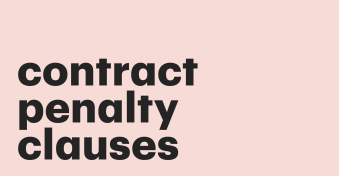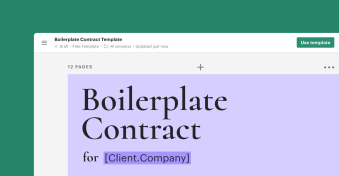Clawback agreements are a risk management mechanism that guarantees equitable resolution in the event of unfair business dealings.
They offer a legal route for companies and investors to recover money and, as such, are a key part of many business contracts today.
Key takeaways
- Clawback agreements allow companies to recoup financial rewards if a partner fails to meet agreed-upon conditions or engages in misconduct.
- These agreements are enforceable by law, provided they are clearly defined in the contract.
- The enforceability of clawbacks hinges on clear evidence of misconduct, failure to meet performance targets or financial inaccuracies.
- Recent regulations have expanded the scope of clawbacks, meaning they’re more prominent than ever in corporate law.
- With software, you can easily manage your contracts and enjoy the legal protection of clawback clauses.
What is a clawback?
A clawback is a type of safety net commonly used in contracts in business.
Essentially, they’re a way of recouping money if someone you’ve entered into a contractual relationship with has acted unfairly or not lived up to expectations.
Financial restitution clauses have existed for hundreds of years.
Clawback agreements specifically, however, gained significant attention during the early 2000s dot-com bubble.
At that time, there were high-profile corporate fraud cases in which top executives “took the money and ran.”
Many people were unfairly left out of pocket, but the contracts they signed were watertight — meaning they needed an equitable remedy.
One of the landmark regulatory responses was the Sarbanes-Oxley Act of 2002 in the United States, which introduced mandatory clawback policies for recovering compensation in cases of financial misconduct.
Since then, the principles behind clawbacks — ensuring accountability and preventing unjust enrichment — have been repurposed for all sorts of business agreements.
So, when we ask, “What are clawbacks?” it’s simply about ensuring everyone plays by the rules and that financial rewards are earned, not just given.
How do clawbacks work?
Clawbacks operate as a form of conditional compensation, where financial rewards are subject to recapture if predefined conditions are not met or misconduct occurs.
So, what’s the process for “clawing back” on an agreement, and when could it apply?
Let’s explore the cases where clawbacks become enforceable.
Proof of misconduct
First, there must be clear evidence that someone didn’t play by the rules.
This could be anything from cooking the books to breaking company policies (or participating in illegal activities, for that matter.)
Failure to meet performance targets
Next, if there were certain goals or performance targets set and they weren’t met, that might trigger a clawback.
The essential factor here is the initial establishment of these targets in a clear, measurable, and equitable manner. (I.e., they must be written into the business contract).
Financial fraud or mistake
Lastly, if it turns out that the financial success was more of a fairytale because of accidental errors or intentional exaggerations in reports, clawback provisions can be applied to recuperate previously awarded compensations.
Regardless of how a clawback is enacted, the underlying theme is that these clauses are not punitive but a restorative form of justice.
A court will only accept a clawback argument if the conditions have been met, there is substantial evidence, and the claimant has followed due process.
The reason why clawbacks exist is to maintain equity in corporate agreements.
In other words, to ensure compensation is fairly earned, aligning with the actual performance of the parties and overall ethical conduct.
Common uses of clawback clauses
Clawback clauses serve as a critical mechanism within various contractual frameworks.
They’re often used in corporate fields, such as corporate law and finance.
Here’s where you’ll most likely find them:
- Employment contracts: To ensure employees who receive bonuses or other incentives stick around and meet their goals.
- Executive compensation: To ensure that executive rewards are directly linked to the long-term performance and ethical standing of the company.
- Investment agreements: To protect investors from losses due to misrepresentation or failure to achieve promised outcomes.
- Government subsidies: To make sure companies follow through on commitments they made in exchange for public funding.
- Insurance policies: To claw back payouts if fraudulent claims are uncovered.
What are clawback provisions?
Clawback provisions are specific contract clauses that are written into most business agreements.
Sometimes, they use other names like “recoupment clauses” or “recovery provisions.”
As for their content, they typically cover what triggers them and how to give back bonuses or other perks if things don’t go as planned.
Importantly, clawback clauses often pay reference to service-level agreements (SLAs), establishing a direct link between performance metrics and compensation.
If these expectations are not met, the clawback provision can kick in to recalibrate the deal.
Clawback agreement examples
Let’s take a look at three hypothetical examples where clawback agreements are used in business contracts and how they may be triggered:
Example 1: Failure to meet performance targets
Imagine a scenario where a tech company introduces a software product with the goal of increasing its market share.
The CEO decides to set clear performance targets for the sales reps, with generous bonuses for those who exceed their quotas.
One sales rep, Alex, signs an employment contract with a clawback clause tied to these targets.
Despite an initial surge in sales, Alex ultimately falls short of the ambitious year-end goal.
Due to the clawback provision, the previously awarded bonus to Alex is recalibrated to reflect the actual sales performance, ensuring that the overall compensation he receives is fair.
Example 2: Proof of misconduct
Now let’s imagine a case where a pharmaceutical company’s CEO, Jordan, is granted stock options as part of his compensation package.
There’s a condition that these options vest based on the company’s performance and ethical compliance.
Later, it’s discovered that Jordan was involved in insider trading to boost the company’s stock price temporarily.
The misconduct here obviously leads to a significant restatement of financial results.
As such, under the clawback agreement within Jordan’s contract, the company decides to retract the vested stock options.
Example 3: Financial reporting mistake
Finally, let’s consider an investment scenario where a startup secures funding from venture capitalists under the condition of achieving certain financial milestones.
The agreement includes a clawback clause for the founders’ shares in case of any manipulation of financial data.
Then, halfway through the fiscal year, an inadvertent error in financial reporting overstates the company’s revenue.
During an audit, the mistake is identified, and investors are notified.
According to the clawback provision, a portion of the founders’ shares must be returned to the investment pool to realign the founders’ compensation with the actual financial state of the startup.
How to write a clawback agreement in 5 simple steps
Writing a clawback agreement doesn’t have to be a headache.
Just follow these simple steps to ensure your business is covered.
Identify the conditions
Start by clearly stating what triggers the clawback.
Is it not hitting sales targets, or maybe something more serious like misconduct?
Write something like, “In the event of failing to meet the agreed-upon performance metrics…“
Define the scope
Be crystal clear about what’s at stake.
Are you talking bonuses, stock options, or something else? Use language like, “This clawback provision applies to all forms of monetary bonuses and vested stock options…“
Set the timeframe
Specify for how long the clawback can be enforced. “This clause is in effect for a period of X years following the issuance of the compensation…“
Detail the process
Explain exactly how the clawback will be executed. “Upon determination of a breach of conditions, the company will…“
Incorporate a contract penalty clause
Include a section that acts as a deterrent against breaches, like, “Failure to comply with the terms may result in mandatory restitution of the full amount of the compensation received…“
Following these steps will help you craft a solid clawback agreement that keeps everyone honest and aligned with your company’s goals.
Once you’ve written your first, you could save some elements as a clawback agreement template to create others.
Pros and cons of using a clawback agreement
Let’s explore the advantages of using a clawback agreement (or why you may want to think twice):
| Pros | Cons |
|---|---|
| Keeps people honest and ensures everyone’s playing by ethical rules. | It can also scare good people away, as some might not like the pressure. |
| Guarantees performance as only those who truly earn their keep hold onto any compensation or bonus. | This can create trust issues, as it does imply “we don’t trust you 100%.” |
| Protects your company’s cash if things go south. | You must spend more time and money on contract writing and admin tasks. |
| Gives you peace of mind with objective performance metrics, which you can use for financial forecasting | Can put too much stress on achieving those targets. |
| Promotes long-term business relationships and performance improvement. | Might lead to cutting corners to meet goals. |
Create, collaborate, and manage all your contracts with PandaDoc’s simplified contract management software
Clawback agreements play a big role in protecting a business’s finances and ensuring equity in contracts for services.
The good news is you don’t have to be a contract lawyer to enjoy their benefits, at least when you use document workflow software like PandaDoc.
Our solution makes contract management a breeze.
We’ve got you covered for the contract’s entire lifecycle, from sending a customized proposal and receiving legally binding eSignatures to automated renewal notification and easy storage for analytics.
Get started with a 14-day free trial!
Frequently asked questions
-
Companies implement clawback agreements for financial risk management. They ensure that if someone doesn’t hit their targets or acts dishonestly, the company can recuperate compensation. It’s a shield against unfair business practices.
-
Yes. As long as everything’s written out clearly in the contract and the law’s on your side, companies can enforce clawbacks to keep things squared away. Of course, their enforceability is contingent upon precise documentation, which is why software like PandaDoc helps protect you.
-
New regulations have widened the scope of clawback agreements, making them mandatory in some business agreements. Notably, the Dodd–Frank Wall Street Reform and Consumer Protection Act of 2010 tightened the reins on financial reporting. Now, if a company has to fix its financial statements because of a mess-up, it can take back bonuses from its execs, even if it wasn’t the exec’s fault.
-
In private equity, clawbacks are used to make sure the managers only keep their share if the investors earn equitable profits themselves. It’s like saying, “We have so much faith in our business that we’ll reward you investors first.”
Disclaimer
PandaDoc is not a law firm, or a substitute for an attorney or law firm. This page is not intended to and does not provide legal advice. Should you have legal questions on the validity of e-signatures or digital signatures and the enforceability thereof, please consult with an attorney or law firm. Use of PandaDoc services are governed by our Terms of Use and Privacy Policy.


